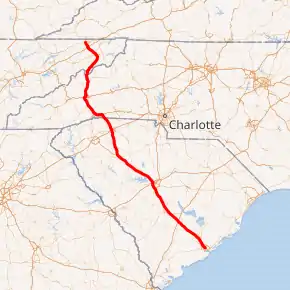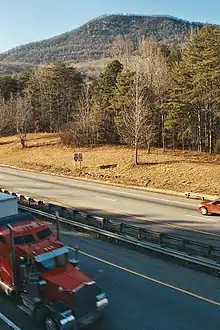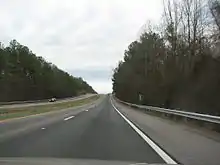Interstate 26
Interstate 26 (I-26) is a nominally east–west (but physically more northwest–southeast diagonal) main route of the Interstate Highway System in the Southeastern United States. I-26 runs from the junction of U.S. Route 11W (US 11W) and US 23 in Kingsport, Tennessee, generally southeastward to US 17 in Charleston, South Carolina.[2] The portion from Mars Hill, North Carolina, east (compass south) to I-240 in Asheville, North Carolina, has signs indicating FUTURE I-26 because the highway does not yet meet all of the Interstate Highway standards. A short realignment as an improvement in the freeway was also planned in Asheville, but has been postponed indefinitely due to North Carolina's budget shortfalls.[3] Northwards from Kingsport, US 23 continues to Portsmouth, Ohio, as Corridor B of the Appalachian Development Highway System, and beyond to Columbus, Ohio, as Corridor C. In conjunction with the Columbus–Toledo, Ohio, corridor formed by I-75, US 23, and State Route 15, I-26 forms part of a mostly high-speed four-or-more-lane highway from the Great Lakes to the Atlantic Coast at Charleston, South Carolina. There are no official plans for extensions north of Kingsport, Tennessee.
| |
|---|---|

I-26 highlighted in red | |
| Route information | |
| Length | 305.62 mi[1] (491.85 km) |
| Major junctions | |
| West end | |
| |
| East end | |
| Location | |
| States | Tennessee, North Carolina, South Carolina |
| Highway system | |
Route description
| mi | km | |
|---|---|---|
| TN | 54 | 87 |
| NC | 53 | 86 |
| SC | 221 | 356 |
| Total | 328 | 529 |
I-26 is a diagonal Interstate Highway, which runs northwest–southeast. The extension north of Asheville is mostly north–south. Where I-26 crosses the French Broad River in Asheville at the Jeffrey Bowen Bridge (previously known as the Smoky Park Bridge), the highway runs in opposite directions from its designations. (I-26 westbound actually goes east. I-26 runs concurrently with I-240, so that I-240 eastbound and I-26 westbound are the same route.) When the extension was made in 2003, the exit numbers in North Carolina were increased by 31 to reflect the new mileage. The part that it shares with I-240 is signed as both I-240 and I-26 but follows the I-240 exit numbering pattern.
I-26 has signs with an extra FUTURE sign above (and in the same style as) the EAST and WEST signs from Asheville north to Mars Hill, North Carolina, because the older US 23 freeway does not yet meet all of the Interstate Highway standards. The road shoulders remain substandard or nonexistent along short sections of the route. A rebuild and relocation is also planned in Asheville to avoid some tight interchanges.
Tennessee

The exit numbers in Tennessee were formerly numbered backward—increasing from east (physically south) to west (physically north)—because this highway was formerly signed north–south as US 23 (and I-181). Although this is consistent with the south-to-north numbering conventions, this exit numbering was changed on all 284 signs along I-26 to be consistent with the rest of the east-to-west-numbered highway in March 2007. The remaining I-181 signs north of I-81 were also replaced with I-26 signs at that time.
For its entire length in Tennessee, I-26 shares the route with U.S. Route 23. The route is named the James H. Quillen Parkway, after Jimmy Quillen, a past member of the U.S. House of Representatives for Tennessee.
In Tennessee, US 23 runs south from the Virginia state line for 1 mile (1.6 km) to Kingsport. I-26 begins at the junction of US 23 with U.S. Route 11W (which is locally named Stone Drive), northwest of the city. After about 1,000 yards (910 m), I-26 crosses the South Fork Holston River before swinging around to a generally south-east path through Sullivan County. It reaches its major interchange with Interstate 81 at exit 8A, southwest of Colonial Heights.
Shortly after entering Washington County, it reaches the northwest part of Johnson City, and also serves as a local transit route as it makes its way around the north and eastern parts of the city. It begins to travel through more obviously mountainous terrain before turning to travel in a south direction. Entering Carter County briefly, it passes exit 27 before entering the Cherokee National Forest and Unicoi County. From this point, it passes through part of the Blue Ridge Mountains, first the Unaka Range and later, as it passes Erwin, Tennessee between exits 34 and 40, the Bald Mountains. It meets the Nolichucky River just after mile marker 38 and travels along its southeast bank before crossing it immediately before exit 40.
The remainder of I-26 in Tennessee passes through a sparsely populated area, at elevations of above 1,800 feet (550 m), before reaching the North Carolina state line.
North Carolina

About 20 miles (32 km) beyond Spartanburg one reaches the foothills of the Blue Ridge Mountains. After crossing the border into Polk County, I-26 intersects with U.S. Route 74, a limited-access freeway near Columbus, and it heads up a 6% grade for the next three miles through Howard Gap. Then it passes over the highest bridge in North Carolina, the Peter Guice Memorial Bridge, 225 feet (69 m) above the Green River between Saluda and Flat Rock in Henderson County, and it crosses the Eastern Continental Divide at an elevation of 2,130 feet (650 m), having climbed from an elevation of around 1,100 feet (340 m) at the US 74 interchange. The land flattens substantially after entering the French Broad River drainage basin from Flat Rock to Hendersonville, Fletcher, and Arden.
I-26 has a major interchange with Interstate 40 in Asheville. After 3 miles (4.8 km), U.S. Route 23 joins I-26 west of Asheville and follows it into Tennessee. The two interstates cross the French Broad River then, having shared the highway for 4.5 miles (7.2 km), immediately part company. As I-240 continues to swing round to the north and east of Asheville, I-26 turns north towards Weaverville and Mars Hill. It enters first the Blue Ridge and then the Walnut Mountains and Bald Mountains of the Appalachian range, passing through the Pisgah and Cherokee National Forests as it does so.
As I-26 crosses the Bald Mountains near the North Carolina/Tennessee state line, it travels through a relatively high-elevation rural area.[4] At Buckner Gap, I-26 reaches 3,370 feet (1,030 m). in elevation.[5] It reaches its highest elevation of 3,760 feet (1,150 m)[6] at Sam's Gap. For 2 miles (3.2 km) each side of the state line, its elevation is at least 3,000 feet (910 m).[7]
I-26 has been deemed a scenic highway in North Carolina between its interchange with US 19/US 23 N (exit 9) and the North Carolina/Tennessee border.[8] At Sam's Gap, the Appalachian Trail crosses under I-26. In addition, northbound travelers are able to see the Blue Ridge Parkway.[9]
South Carolina

Beginning in the city of Charleston, I-26 travels northwesterly over flat plains with little urbanization past Summerville. After the junction with I-95 just inside of Orangeburg County, the terrain becomes somewhat hilly. Orangeburg is the first major stop outside Charleston with several exits bearing this name. Between Orangeburg and the junction with Interstate 77 just outside Cayce the highway goes up and down a few very long hills averaging about 100 feet (30 m).[10] Beyond Interstate 77 is the Columbia metropolitan area with lodging, dining, and shopping possibilities. This metropolitan area ends mostly after exit 101, past which the terrain becomes somewhat hilly once again. The next major city is Newberry. Later, I-26 splits off north toward Spartanburg, where I-26 has a junction with the Interstate 85 corridor, which has a significant amount of international business and manufacturing.
I-26 is deemed a hurricane evacuation route in South Carolina. During hurricane evacuation, lane reversal on I-26 will occur between its junctions with I-526 in Charleston and I-77 in Columbia.[11] This is to aid travelers leaving the Charleston area. Lane reversal on I-26 has been used, such as during evacuations for Hurricane Florence in September 2018.[12]
History
Funding for I-26 in South Carolina was provided by the Federal Aid Highway Act of 1956. The first section of I-26 was built in South Carolina, between Columbia and Charleston. Construction started in 1957 and ended in 1969, with this interstate portion opening on September 7, 1960.[13] By fall 1960, I-26 was complete from Spartanburg to Columbia, and in February 1969, I-26's construction from the South Carolina/North Carolina border to Columbia was completed at a cost of $118 million.[14]
The first section of I-26 in North Carolina consisted of 14 miles of the interstate near Hendersonville, which opened in January 1967. I-26 between the South Carolina/North Carolina border and Asheville was completed in 1976, at a cost of $54.1 million.[14]
The planning for an extension of I-26 from Asheville to I-81 near Kingsport started in 1987 to accommodate truckers traveling toward I-81 that were banned on US 19 and 23. I-26 from Mars Hill, NC to the North Carolina/Tennessee border opened in August 2003 at a cost of $230 million. Also in 2003, the full extension of I-26 from the North Carolina/Tennessee border to I-81 was completed and opened.[14][15]
Interstate 181
| |
|---|---|
| Location | Johnson City–Kingsport, TN |
| Length | 23.85 mi[16] (38.38 km) |
| Existed | 1985–2007 |
Interstate 181 (I-181) was established in December 1985 as an interstate designation of US-23, which was already built to interstate standards in the 1970s. I-181 traversed from US-321/SR-67, in Johnson City, to US-11W/SR-1, in Kingsport, totaling 23.85 miles (38.38 km). US-23 continued on both directions as interstate grade to the Virginia line, to the north, and 15 miles (24 km) south to Erwin; by 1992, US-23 was upgraded to interstate grade south to Sam's Gap, at the North Carolina line. All exit numbers were based on US-23 mileage. On August 5, 2003, after completion of a 9-mile (14 km) section completed in North Carolina, I-26 was extended west into Tennessee, replacing I-181 from Johnson City to I-81; north of I-81, I-181 continued into Kingsport. The American Association of State Highway and Transportation Officials (AASHTO) initially ruled against an extension of Interstate 26 (as the number) along the remainder of I-181 to Kingsport, since that would give a main route Interstate Highway (I-26) a so-called "stub end," not connecting to any other Interstate highway, to an international border, or to a seacoast. The numerical extension was in 2005 enacted by the effect of the Safe, Accountable, Flexible, Efficient Transportation Equity Act: A Legacy for Users, signed into law on August 10, 2005. In March 2007, I-181 was officially decommissioned, as all signs and exit numbers were changed-over to I-26's designation.[17][18][19]
Exit list
Auxiliary routes
- Interstate 126 is a spur into Columbia from the northwest; established in 1961, it shares complete concurrency with US 76.
- Interstate 326 was an unsigned designated spur to SC 48 in Columbia; approved in 1976, it was decommissioned in 1995 in favor of I-77.
- Interstate 526 is a partial beltway of Charleston, running from US 17 west of the city north to I-26 and back east and south to US 17 in Mount Pleasant; it was established in 1989 and features a business spur on its eastern terminus.
References
- Adderly, Kevin (January 15, 2014). "Table 1: Main Routes of the Dwight D. Eisenhower National System Of Interstate and Defense Highways as of December 31, 2013". Route Log and Finder List. Federal Highway Administration. Retrieved March 10, 2014.
- Google (February 15, 2008). "Overview Map of I-26" (Map). Google Maps. Google. Retrieved February 15, 2008.
- Newsome, Angie (March 29, 2011). "I-26 Connector on Hold Indefinitely". Mountain Xpress. Asheville, NC. Retrieved March 29, 2011.
- "I-26 Scenic Highway". Blue Ridge National Heritage Area. Retrieved August 15, 2019.
- "The New I-26 Virtual Tour". Millenniumhwy.net. Retrieved November 27, 2011.
- "Sams Gap: NC/TN Border". Waymarking.com. Retrieved November 27, 2011.
- Sams Gap (Map). Maptech. Retrieved November 27, 2011.
- "America's Scenic Byways::Interstate 26 Scenic Highway". scenicbyways.info. Retrieved August 15, 2019.
- "I-26 Scenic Highway". www.romanticasheville.com. Retrieved August 15, 2019.
- "Google Maps". Google Maps. Retrieved August 15, 2019.
- https://ops.fhwa.dot.gov/eto_tim_pse/reports/2010_cong_evac_study/fhwahop10059.pdf
- Slade, David; Jackson, Angie (September 11, 2018). "Lanes reversed for evacuations, but I-26 near Charleston carried half the normal traffic". Post and Courier. Retrieved August 15, 2019.
- "South Carolina's first freeway, snapshots from the past". Post and Courier. Retrieved August 15, 2019.
- Webmaster. "Interstate 26". Interstate-Guide.com. Retrieved August 15, 2019.
- "OKRoads -- Interstate 26". www.okroads.com. Retrieved August 15, 2019.
- Google (December 2, 2013). "Interstate 181 (Tennessee)" (Map). Google Maps. Google. Retrieved December 2, 2013.
- Allen, Calvin (July 16, 2003). "The Political History of I-26". Mountain Xpress. Asheville, NC. Retrieved December 2, 2013.
- Special Committee on U.S. Route Numbering (May 31, 2003). "Report of the Special Committee on U.S. Route Numbering to the Standing Committee on Highways" (PDF) (Report). Washington, DC: American Association of State Highway and Transportation Officials. p. 11. Archived (PDF) from the original on October 16, 2017. Retrieved December 2, 2013.
- Special Committee on U.S. Route Numbering (May 6, 2006). "Special Committee on U.S. Route Numbering Approved Applications" (PDF) (Report). Washington, DC: American Association of State Highway and Transportation Officials. p. 1. Archived (PDF) from the original on October 16, 2017. Retrieved December 2, 2013.
External links
 Media related to Interstate 26 at Wikimedia Commons
Media related to Interstate 26 at Wikimedia Commons Geographic data related to Interstate 26 at OpenStreetMap
Geographic data related to Interstate 26 at OpenStreetMap- News article listing new I-26 exit numbers published March 2, 2007
- Amberg, Rob (June 5, 2007). "I-26, Corridor of Change". Southern Spaces.
